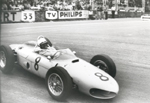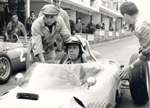EF02 FERRARI DINO 156 F1 1961 ( telaio/chassis 0002)
( I ) Il 1961 fu un anno molto importante per la storia della Ferrari monoposto Formula 1. Infatti, per la prima volta nei gran premi, le macchine Ferrari usarono la propulsione di un motore posto… dietro le spalle del pilota. Fino ad allora, la regola assoluta, voluta dallo stesso Enzo Ferrari, era che “i cavalli tirano la carrozza, non la spingono”, e fu difesa fino all'ultimo, fino a quando non fu più possibile negare la supremazia delle macchine a motore posteriore. La 156 F1, dotata di un motore a 6 cilindri a V di soli 1500 cc si rivelò subito come una macchina vincente. Il progetto dell'ingegnere Carlo Chiti fu uno dei primi ai quali partecipò anche il giovane ingegnere Mauro Forghieri, che avrebbe poi firmato decine di macchine vincenti negli anni seguenti. Dopo il secondo posto di Ginther a Monaco e la vittoria di Von Trips in Olanda, al terzo appuntamento della stagione sul circuito di Francorchamps, il 18 giugno, la Ferrari si presentò con quattro macchine, tre dotate del motore a V da 120°, per Ginther, Hill et Von Trips, e una con il motore a V da 65° per il pilota locale Olivier Gendebien, dipinta con il colore della Scuderia Francorchamps, il giallo, che partì in prima linea vicino all'americano che sarebbe diventato Campione del Mondo alla fine di quella stagione e del tedesco che avrebbe perso la vita nel Gran Premio d'Italia seguente. Durante la corsa non ci fu storia, le 3 Ferrari rosse salirono sul podio e la Ferrari gialla occupò un'onorevole quarta posizione. Dobbiamo risalire al Gran Premio di Germania del 1952 per ritrovare la Ferrari con un simile quartetto. Fu l'unica volta in cui Gendebien guidò una monoposto della Scuderia: infatti, il Commendatore lo considerava più adatto alle vetture da Sport e Gran Turismo nelle corse di resistenza, cosa che sarebbe stata confermata dalle sue vittorie. Durante la corsa seguente, il Gran Premio di Francia a Reims, la macchina con il motore a 65° fu affidata a Giancarlo Baghetti che avrebbe così debuttato in Formula 1.
(GB) 1961 was a very important year in the history of Formula 1 Ferrari cars, as this was the first time that their GP cars were powered by an engine located behind the driver. Up until then, the inflexible rule imposed by Enzo Ferrari was that “the horses pull the cart, they don’t push it”. This edict was defended to the bitter end, until it was no longer possible to deny the supremacy of mid-engined cars. The 156 F1, powered by a V6 of just 1500 cc capacity, immediately proved to be a winning design. The project by the engineer Carlo Chiti was one of the first involving the participation of the young Mauro Forghieri, who would go on to create dozens of victorious cars over the following years. After Ginther’s second place at Monaco and Von Trips’ win in Holland, on June 18, Ferrari arrived at the third appointment in the season at Francorchamps with four cars, three of which powered by the 120° V engine, driven by Ginther, Hill and Von Trips, and one with the 65° V engine, driven by local driver Olivier Gendebien and painted in the yellow livery of the Ecurie Francorchamps. This latter car started from the first row near the American, who was to win the world championship at the end of the season, and the German, who was to lose his life during the following Italian GP. In a spectacular display of superiority, the three red Ferraris took the podium, with the yellow car securing an honourable fourth place. The last time four Ferraris had taken the first four places was the German GP of 1952. This was the only time that Gendebien was to drive an official Ferrari GP car, as the Commendatore considered him to be better suited to driving Sport and Gran Turismo cars in endurance racing – and this conviction was to be proven by the driver’s many wins. In the following race, the French GP at Reims, the car with the 65° V engine was driven by Giancarlo Baghetti in what was his Formula 1 debut.
|


